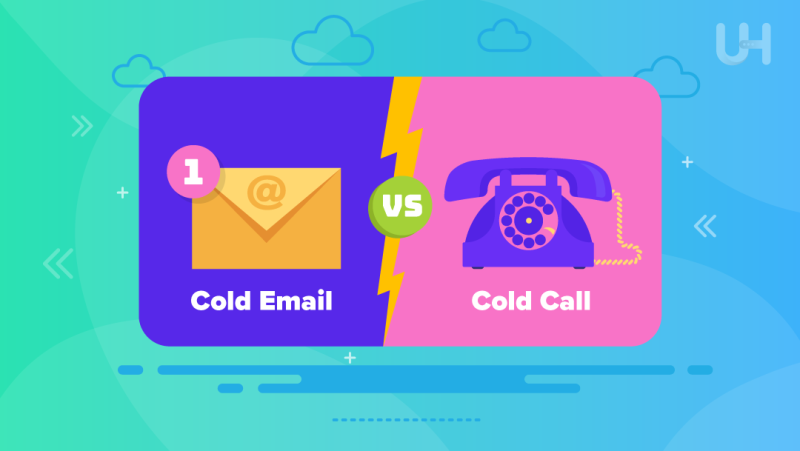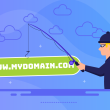With the growing number of communication channels, choosing the ideal channel to reach your prospects can get confusing sometimes. The cold outreach strategy has been around for decades now and has proven beneficial for business growth. However, both these techniques have certain perks and setbacks that you should know about to generate leads effectively. In this post, we’ll compare cold email vs cold call to help you decide which one is better to reach and engage with your potential prospects.
Cold Emailing Overview

Cold emailing is a sales or marketing technique that involves sending emails to potential customers without any previous contact. The primary purpose of this technique is to let the receiver know about your business offerings and, in some cases, get a response back from them.
When writing a cold email, you should keep in mind the strategies that encourage the recipient to open, read, and respond to you. You can start with a brief introduction about yourself, communicate the value you provide, and a CTA for them to take the next step.
Your CTA depends on the audience you are targeting. For example, if you are targeting businesses for them to build lasting relationships with customers, your CTA could be anything from replying to the email to utilizing a special offer like an affordable CRM, which catches their attention. This eventually builds a relationship over time, which leads to a sale.
As good as this strategy seems, it needs strategic targeting to increase open and response rates. Some pros and cons of cold emailing are as follows:
Pros
Some advantages that make cold emailing an effective lead-generation strategy are:
- Scaling is easily done with email automation tools. You can connect multiple email accounts to these tools and send cold emails to thousands of prospects in a short time period.
- Prospects have the flexibility to respond whenever they are free. This gives them more control as they don’t feel pressured like in cold calls.
- You don’t have to be quick and precise with the prospects. You can craft a detailed email for your prospects to get a clear picture of your offerings.
- With email tools, you can track who opened, clicked, or replied to your email. Tracking this data helps in improving your campaigns by making them more effective.
- You don’t need to rely on multiple salespersons to send multiple emails. With cold emailing, you can cost-effectively reach a larger audience in no time.
Elevate Your Outreach Strategy To Generate More Leads!
Ready to Elevate Your Outreach Strategy? Get the best email hosting solution from UltaHost and promote your site and services with every message you send with your website-matching email address.
Cons
Just like all other strategies have certain limitations, this one is no exception. Some disadvantages of cold emailing are:
- With tons of emails, such as newsletters, promotional offers, and personal messages, piling up in people’s inboxes, there’s a very low probability of them opening and responding to your email.
- Depersonalized emails might never reach your target prospects since some email service providers have systems that automatically identify suspicious emails and put them in the “spam” folder.
- You have to put in extra effort to convey your message through text. It should sound interesting, or else the recipient might get bored and ignore or delete your email.
Cold Calling Overview
Cold calling is an outreach method that takes your prospect by surprise. You make calls without any advance notice and pitch about your product with the intent of selling it.
The process is simple: dial up your potential prospect and start by introducing yourself and your business. After making the call, you can also enhance your approach by following strategic cold calling tips, which can significantly improve your success rate.. If your prospect seems interested, you can continue with the call and offer information about your offerings and what step they should take next.
If done effectively, you can generate new leads faster and build relationships with potential customers, eventually increasing your business sales. However, there are still some positive and negative sides to this marketing technique. Let’s look into some of them.
Pros
Cold calling has certain benefits that make it the ideal choice for businesses looking to generate leads quickly. Some advantages are:
- You get to have two-way communication, and the potential customers can clear any doubts or confusion by asking questions, which creates a sense of understanding.
- If a prospect sounds confused, you can provide more clarity on a particular topic by picking up on tones when on call.
- You can adjust your pitch accordingly on call to build a connection with a potential customer by sensing their emotions through tone of voice.
- Simple messages are conveyed more effectively and quickly on calls, while emails need a lot of text to build a picture in the prospect’s mind.
Cons
Some limitations that you should know about before opting for this method are:
- Getting a cold call in the middle of a busy day can be an interruption. People are likely to ignore or just cut the conversation by hanging up.
- Cold calls have a lower lead conversion ratio since a high number of target prospects are busy during business hours.
- Reaching out to multiple prospects needs a lot of salespersons to call them. This method is expensive and also requires initial training for cold calling.
- Cold calling a business may not be effective since some receptionists or assistants filter out unnecessary calls reaching the original decision maker.
Cold Emailing vs Cold Calling: Difference Between Them
Persuading a customer through cold outreach takes a lot of effort, and mistakes in later sales stages can be costly. Everything must run smoothly. To be sure, use fast NVMe VPS hosting for your websites, ensuring your pages load quickly. It’s frustrating for a customer to open a slow page after getting a cold email, and you wouldn’t want that.
After sorting the speed issues of your server, you just have to choose between a cold call or cold email. With the difference highlighted below, you can select the best outreach effort according to the needs of your business.
Personal Experience
A successful sales pitch needs the creation of a personal experience. You can achieve this with both outreach efforts, but they do have some differences.
Cold calling is valued in B2B marketing as it establishes a personal connection through real-time conversations. With cold calling, you can make adjustments based on the prospect’s needs, allowing a dynamic experience.
On the other hand, cold emails can be highly effective when personalized. Automation through software makes cold emailing more efficient and scalable, especially when reaching out to multiple recipients.
Information Gathering
Gathering valuable information, such as the prospect’s point and what they hope to accomplish, is very important in cold outreach. If we talk about a cold call vs email in this scenario, extracting these details while maintaining a human connection is easier with cold calling.
Cold calling allows for real-time interaction, and a well-scripted pitch can acquire more information from the prospect. Cold emailing is effective for simple questions, providing prospects the space to respond thoughtfully and making it a valuable method for information gathering without the pressure of a live call.
Disruptive To Prospects
You must schedule your outreach strategies in a manner that doesn’t disrupt routines and annoy prospects. Cold calling is considered an “old-school” approach and can be invasive, leading to frustration and resistance from cold leads. On average, it takes eight attempts to connect with a prospect.
On the other hand, cold emails are less disruptive, providing flexibility for recipients to open and respond at their convenience. They are also time-efficient compared to lengthy cold calls. Cold emails may be legal, but adherence to regulations is essential. Distinctions between cold email and spam should be maintained to stay on the right side of compliance.
Cold Call vs Cold Email Success Rate
The success rates between a cold call vs email outreach differ significantly. Barriers like voicemail or caller IDs make cold calling inconsistent. According to a study, 58% of prospects find sales calls useless, while 87% feel that salespeople don’t understand their needs, giving it a success rate of only 0.3%.
However, cold emailing has an average response rate of 1-5%. Targeted emails can elevate this to 15-25%, and the format allows for social proof integration, such as user testimonials. 88% of consumers trust this social proof as much as a personal recommendation.
Trackable
You can get excellent trackability for both outreach methods with the right software. Cold calling utilizes tools like Myphoner, VanillaSoft, and Toky, which allows you to enhance lead generation by tracing calls to specific campaigns. These tools offer features like automated dialing, call recording, and detailed analytics, including outgoing calls, average call time, and answer rate, to streamline the process.
Cold emailing is easily monitored since it’s digital. Email automation software facilitates tracking crucial metrics such as open rate, click-through rate, and unsubscribes. With the help of automation software, you can personalize and automate your emails, simplifying the cold emailing process.
Scalable
Cold emailing is more cost-efficient and scalable as it allows for sending several sales emails at a time. You don’t need to hire or train new salespeople for scaling efforts. On the other hand, cold calling requires special skills to convince prospects. To effectively scale your cold outreach method, you need to hire and train a sales team. It can be costly, especially if hired people need further training.
Is It Better to Cold Call or Email?
No matter which approach you choose, cold email or cold call, the purpose of each is to prospect new leads and initiate contact with potential customers. Yes, these strategies do have different approaches, mediums, and dynamics, but the goal is to generate new leads and guide them through the sales funnel.
The nature of your product or service, the preference of your target audience, and the stage of your sales planning process are the factors that decide which cold outreach method you should integrate into your business. Each method has its perks and can be effective with the right resources and your team’s talent.
Cold Email vs Cold Call: Which One To Choose?
Cold emailing is the first choice to go after to market your campaign and increase brand awareness. But for building relationships, cold calling fits best in the scenario. The main advantage of a cold email is reaching multiple prospects cost-effectively, but with cold calling, you can make a compelling first impression with your tone and convincing energy, even if you don’t cover a wider audience. Both methods have their negative and positive sides. Trying each one yourself is the best way to determine which one fits the requirements of your business and helps in lead generation.
If you found this exploration of cold email vs cold call insightful, consider experiencing the efficiency of UltaHost’s hosting platform. Explore our VPS hosting service with 24/7 support, prioritizing optimum flexibility, unlimited bandwidth, and performance.
FAQ
Are cold emails better than cold calls?
Cold emailing and cold calling each have their advantages and disadvantages. The choice between the two strategies depends entirely on your industry, business, and ultimate objectives.
Who uses cold emails?
Cold emails are employed by a diverse range of professionals, including salespeople, recruiters, marketers, PR professionals, fundraisers, consultants, realtors, lawyers, HR professionals, and non-profits. This helps in building connections with targeted prospects.
How many cold emails should you send per day?
There’s no dedicated number of emails to send in a day. Depending on the size of your team and business goals, you shouldn’t be sending more than 50 emails per account in a day.
Is there anything more effective than cold calling?
If your target audience prefers not being disturbed during their daily routine, you can opt for email marketing since it puts control in customers’ hands and relieves them of any pressure to take action.











